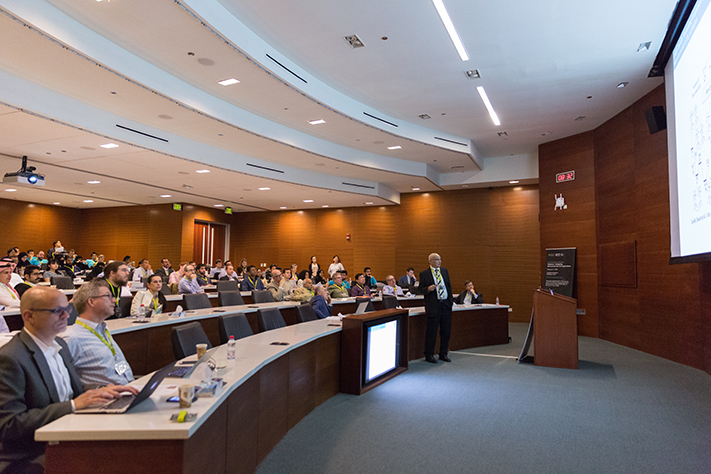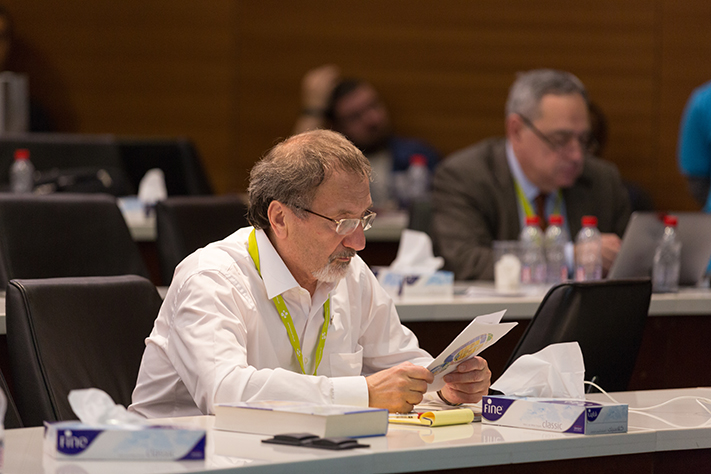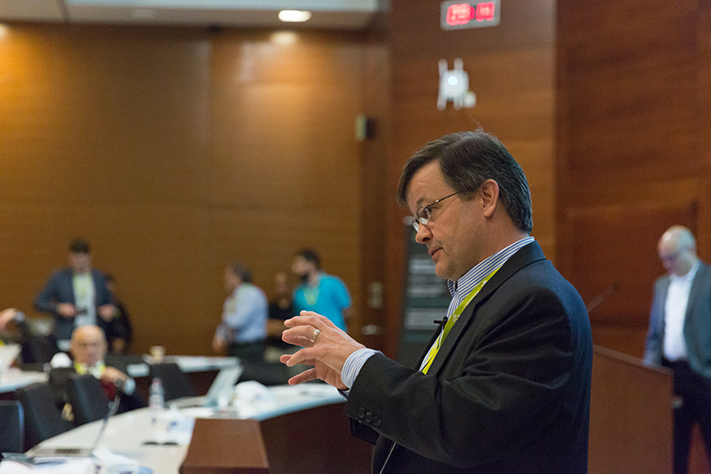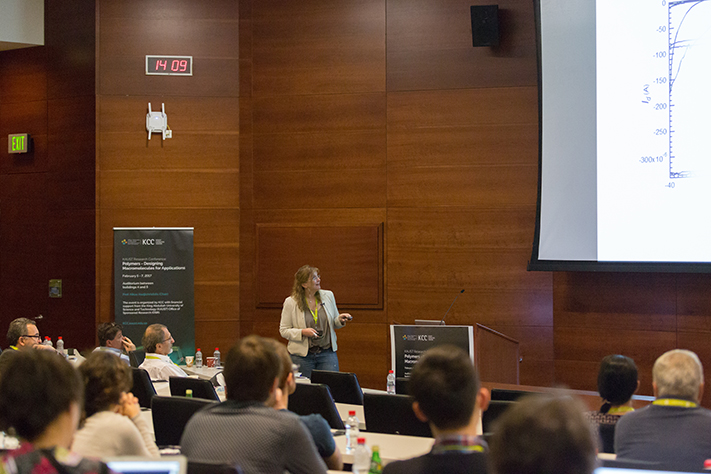Combining polymer expertise

Jean-Marie Basset, KCC director, giving his opening remarks for the KAUST Research Conference on Polymers: Designing Macromolecules for Applications. Photos by Lilit Hovhannisyan.
The University recently held the KAUST Research Conference on Polymers: Designing Macromolecules for Applications from February 5 to February 7. The conference, which was chaired by Distinguished Professor Nikos Hadjichristidis from the KAUST Catalysis Center (KCC) , drew attention to the ubiquitous role polymers play in industry, nature and everyday life and the design/synthesis, processing and application of polymers that constitute an important strategic research area worldwide.
The cross-disciplinary conference attracted global researchers and scientists and covered the most appealing topics in contemporary polymer science and technology, including recent developments, trends and perspectives in catalytic polymerization and polymer catalysis, macromolecular architecture and characterization, properties-structure relationships and high-tech applications for solar cells, membranes and biomaterials, for example.

Event chair and Distinguished Professor Nikos Hadjichristidis from the KAUST Catalysis Center (KCC). Photo by Lilit Hovhannisyan.
The problem of energy

Event chair and Distinguished Professor Nikos Hadjichristidis from the KAUST Catalysis Center (KCC). Photo by Lilit Hovhannisyan.
“We scientists are facing a very interesting time in the world with the problem of energy. We aspire to be a world-leading center in the Kingdom and in the Middle East,” he said.
Robert Waymouth, professor in chemistry and chemical engineering at Stanford University, opened his keynote address by highlighting that natural gas production has gone up and that new polymer architecture needs to be availed of to harness CO2.
“If we don't use hydrocarbons, they will flare them and they will go to CO2," he said. "We should come up with new polymer architectures that allow these to be utilized. As polymer scientists, we sometimes stumble on designs and figure out how they work later on."

Robert Waymouth, professor in chemistry and chemical engineering at Stanford University giving his keynote lecture. Photo by Lilit Hovhannisyan.
Cell construction and generation

Robert Waymouth, professor in chemistry and chemical engineering at Stanford University giving his keynote lecture. Photo by Lilit Hovhannisyan.
“Most of the organic cells you encounter will be a thin film. We would ideally like to go to thicker cells, and with polyethylene we can get a lot of different blends. We can change the microstructure with polyethylene—the more crystalline the structure is, the more we can add to it,” she said.
“When you make films, many of your materials like to go to the electrode and not onto the substrate, and when we add the nucleating element, this doesn't happen. This is helpful as it makes things substrate-independent. Assigning a tiny bit of the nucleation agent gives us decent films, and with a nucleating agent added, crystallization proceeds much faster,” she continued.
‘Customers buy solutions—they don't buy polymers’
“Innovation is really the future for Saudi Aramco. There was a need to develop new catalyst systems with high turnover rates, excellent selectivity and high productivity. This required a lot of development to find catalysts suitable for commercial polymer production, and it was a non-trivial challenge to find real applications for the polymers," he noted.
Farmer also spoke about the need to create cost-effective polymers and the continued use of CO2 in their production.
“If you can find productive uses for CO2, this is very attractive. CO2 also provides a cost advantage—making a polymer with CO2 means up to 50% of the mass of the polymer can be made from CO2," he said. "This has a big impact on the sustainability story of the polymer. These materials really impart some very fascinating properties in the marketplace, and the applications for these are wide-ranging. Customers buy solutions—they don't buy polymers."

Professor Natalie Stingelin from the School of Chemical & Biomolecular Engineering at Georgia Tech during her keynote address. Photo by Lilit Hovhannisyan.
Advancing manufacturing
Long also spoke about his Virginia Tech team's research and development work in materials science with 3-D printing.
“We're interested in small things for biomedical applications. Ionic liquids have no smell or odor and you can 3-D print them. However, there is always concern about 3-D printing layer by layer. If you 3-D print energy sources, there are many applications. There are all kinds of opportunities and applications galore,” he said.
Combining expertise
Ingo Pinnau, professor of chemical and biological engineering and director of the KAUST Advanced Membranes & Porous Materials Center (AMPMC), discussed the role of his center and how it adds to the overall University’s goal and vision.
“Our center is focused on the development of energy, materials and processes for energy-intensive separations. At KAUST, we have custom-designed equipment to carry out membrane studies. We have large expertise in our center combining the polymer group's expertise with the metal organic framework group,” he said. "At this conference, we want to try to align our research activities better with industry."Pinnau introduced closing speaker Jean M. J. Fréchet, KAUST distinguished professor of chemical science and the University’s vice president for research, as the "most creative polymer scientist and an amazing scientist." Fréchet highlighted the need for ongoing collaboration to spark new ideas and outlooks.
“Bringing people here is the way to start collaboration and hear about new ideas,” he said.
The conference's poster session winners were also announced in the closing remarks. Yahya Alzahrany, a Ph.D. student in the Polymer Synthesis Laboratory, won best poster prize for his poster entitled “A powerful initiating system for alternating copolymerization of CO2 with epoxides."
Johannes Brendel from Friedrich Schiller University, Germany, and Saheli Chakraboty from the Indian Institute of Science won second and third places, respectively.
"The level of the posters was so good that we would have liked to have given prizes to everyone," Hadjicristidis said.
The conference was organized with financial support from the KAUST Office of Sponsored Research (OSR), and additional support provided by the KAUST Industry Collaboration Program (KICP), Industry Partnerships Office.
- By David Murphy, KAUST News

